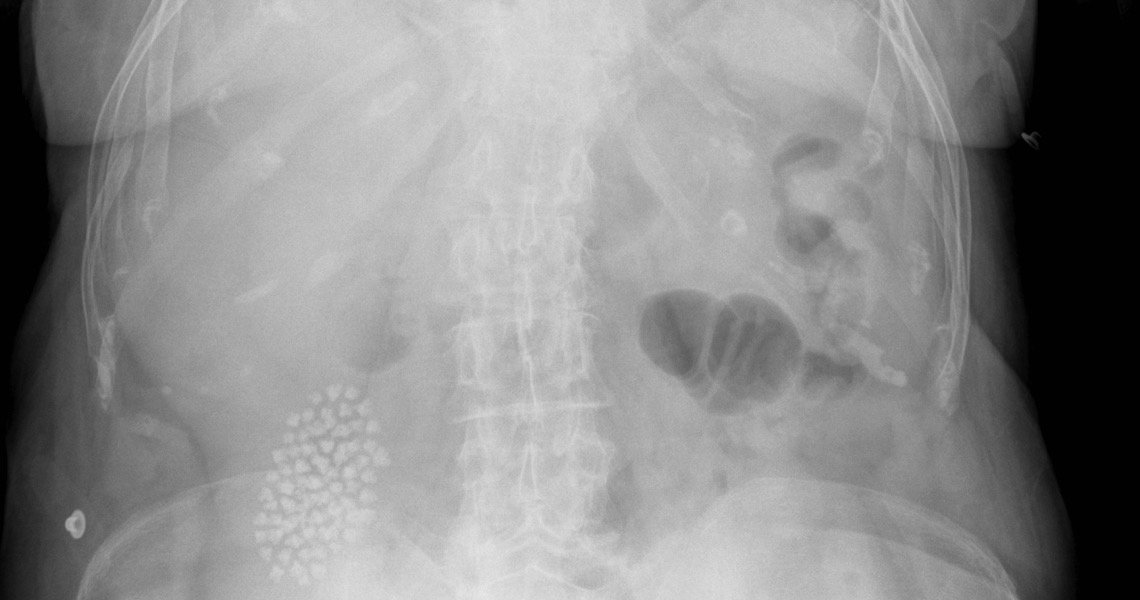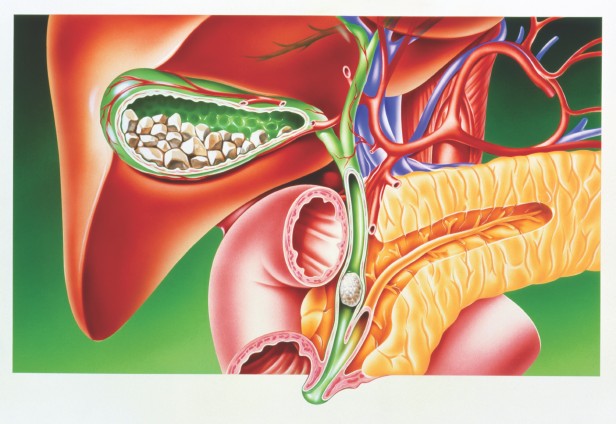Gallstones are among the most common problems of the digestive tract.
Between four and five thousand patients suffering from gallstone related problems are operated in Slovenia each year. The number of patients is on the rise. Gallstone related problems may occur at any age, but the frequency increases with age. Gallstones occur in the gall bladder, an organ situated just below the liver. It collects bile that is created in the liver and flows down a number of tiny channels into the gall bladder. The bladder is connected via a thin duct with the duodenum, the first section of the intestine that receives the contents of the stomach. At the end of the duct, just before entry into the duodenum, another duct comes in with digestive enzymes from the pancreas. The gall bladder is a reservoir for bile which empties into the duodenum as food enters the intestine from the stomach. Gallstones consist mostly of cholesterol, pigment and calcium salts. Ingredient concentrations in the gall bladder are approximately ten times higher, so stones form mostly in the bladder and very rarely in the bile ducts.

Reasons for occurrence
There are many risk factors that contribute to the occurrence of gallstones. The most important among them are sex (gallstones occur more often in women due to the influence of sexual hormones and pregnancy), increased body weight and obesity, rapid weight loss through dieting and age. Gallstones often form in persons with damaged spinal cords and those who receive parenteral nutrition (intravenous feeding) for several months.
Problems caused by gallstones
The majority of persons with gallstones experience no problems. Such asymptomatic gallstones are discovered that are discovered by coincidence during ultrasounds of the abdomen due to unrelated symptoms or illnesses. Patients suffering from a gallstone attack describe sudden and constant pain that occurs on the right side below the ribs, lasts from 15 to 30 minutes and may radiate to the back or under the sternum. Pain can be accompanied by nausea and vomiting. If the pain does not abate and persists for several hours, it is likely that the patient is experiencing inflammation of the gall bladder, pancreas or another serious abdominal condition, so medical assistance is absolutely necessary. A physician will examine the abdomen, take blood samples for testing and depending on the results decide on a further ultrasound of the abdomen or other tests.
Treatment
Persons whose gallstones are discovered accidentally and have no symptoms do not require treatment. If a patient is not experiencing problems, surgical treatment is not necessary, except in diabetics, persons with large polyps in the gall bladder, carriers of Salmonella and patients with a weakened immune system. Pain due to gallstones can be treated by spasmo-analgesics and antibiotics in case of inflammation. Considering the severity of the illness the physician then decided between clinical and surgical treatment. Recurring problems due to gallstones are remedied best with a surgical removal of the gall bladder.
Gallstones can be discovered accidentally during an abdominal ultrasound due to an unrelated problem or illness.
The most effective solution for patients experiencing frequent cramping pain on the right side under the ribcage is a surgical removal of the stones. Nowadays most procedures are carried out laparoscopically, meaning that instruments are introduced through small incisions and guided with the aid of a micro camera feeding images to a screen. The procedure is called laparoscopic cholecystectomy. The less invasive technique allows for faster recovery and less time spent in hospital. Complications are rare, but possible as in any surgical procedure.
In certain cases the circumstances in the abdomen, major inflammation, anatomic variants or accompanying illnesses prevent the performance of a laparoscopic procedure, requiring a classical operation through an incision under the right side of the rib cage. The most common complication of gallstones is a closure of the common bile, liver and pancreatic duct leading to the minor intestine. The most common symptom is abdominal pain, followed by yellowing of the skin (jaundice) and vomiting. Inflammation can also be followed by a fever. Other potential complications include inflammation of the pancreas and increased likelihood of cancer.
